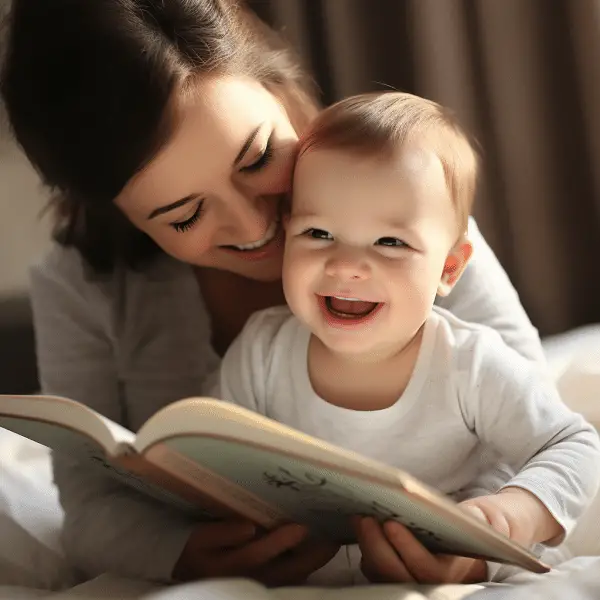Nurturing Language and Literacy: Baby Communication
Nurturing Language and Literacy: Baby Communication Baby language is a fascinating aspect of infant communication. It involves understanding the various signals, gestures, and cries that babies use to express their needs and emotions. By learning to decipher baby language, parents can better respond to their baby’s needs and create a stronger bond with their little one.
Key Takeaways:
- Understanding baby language is essential for effective communication with infants
- Baby language includes signals, gestures, and cries
- Deciphering baby language helps parents meet their baby’s needs and strengthens the parent-child bond
- Learning baby language enhances the overall well-being of the child
- Understanding baby language leads to better parenting and nurtures a harmonious parent-child relationship

The Sensitive Period for Language Development
During the early stages of a baby’s life, there is a sensitive period for language development that occurs around six months of age. This period is crucial for the development of fluent tones and cadences, which are essential for becoming a native speaker. Research has shown that babies’ brains are highly receptive to learning the sounds and patterns of language during this time.
To take advantage of the sensitive period, parents can expose their babies to a variety of language sounds and engage in verbal interactions. By speaking to their babies in a clear and expressive manner, parents can help their little ones develop a strong foundation for language skills. It is also beneficial to introduce different languages or dialects, as exposure to diverse linguistic environments can enhance language learning abilities.
The sensitive period for language development is an ideal time for babies to absorb the rhythm, intonation, and phonetic elements of their mother tongue. It is important for parents to create a language-rich environment and provide ample opportunities for babies to engage with sounds and words. By doing so, parents can support their babies’ language development during this critical period and lay the groundwork for future language acquisition.
Table:
| Ways to Support Language Development during the Sensitive Period |
|---|
| Engage in frequent verbal interactions |
| Expose babies to a variety of language sounds |
| Speak in a clear and expressive manner |
| Introduce different languages or dialects |
| Create a language-rich environment |
The Role of “Parentese” in Language Learning
When it comes to language learning in babies, the role of “parentese” cannot be overstated. Parentese refers to the exaggerated way in which parents speak to their babies, characterized by high-pitched and sing-song tones. This unique form of speech helps babies learn the intonations and cadences of their native language, laying the foundation for their language development.
Research has shown that babies are highly attuned to the features of parentese. They are naturally drawn to the exaggerated sounds and rhythms, and this helps them pick up on the nuances of language. By engaging in parentese, parents create a nurturing and stimulating environment for their babies’ language learning journey.
Using parentese is not only beneficial for language learning, but it also strengthens the bond between parent and child. The exaggerated tones and expressions capture the baby’s attention and create a positive and engaging interaction. This form of communication fosters a sense of connection and promotes social-emotional development in babies.
“Parentese has been found to be a powerful tool in helping babies learn language. The exaggerated intonations and cadences provide important cues that help babies distinguish between different sounds and words. It also helps them understand the rhythm and melody of language, which is crucial for developing fluent speech.”
Enhancing Language Learning with Parentese
To make the most of parentese, parents can incorporate it into everyday interactions with their babies. Here are some tips for enhancing language learning through parentese:
- Use exaggerated facial expressions and gestures to accompany your speech.
- Speak slowly and enunciate words clearly.
- Repeat important words and phrases.
- Engage in back-and-forth conversations, even if your baby is not yet speaking.
- Read books with expressive voices and emphasize the rhythm of the text.
By using these strategies, parents can create a language-rich environment that promotes their babies’ language learning and overall development. Remember, parentese is not only a way to communicate with your baby, but it is also a way to bond and connect on a deeper level.
| Benefits of Parentese: | Strategies for Using Parentese: |
|---|---|
|
|
The Role of Attachment in Language Development
Attachment plays a significant role in language development in infants. When babies form a secure attachment with their caregivers, it creates a nurturing and supportive environment for language learning. Secure attachment is characterized by a strong emotional bond, trust, and responsiveness between the baby and caregiver. This emotional connection provides a foundation for effective communication and language acquisition.
Research has shown that babies who have secure attachments tend to have better language skills compared to those with insecure attachments. When babies feel safe and loved, they are more likely to engage in verbal interactions and imitate the sounds and words they hear from their caregivers. This back-and-forth communication helps babies learn the rhythms, patterns, and vocabulary of their native language.
On the other hand, insecure attachments can have long-lasting effects on a child’s language development. In infants with insecure attachments, there may be less verbal interaction, inconsistent responsiveness, or a lack of emotional connection with their caregivers. These factors can hinder language learning and delay language acquisition.
Creating a secure attachment with your baby involves responsive caregiving, providing comfort and support, and engaging in positive interactions. By fostering a strong emotional bond, you can create an environment that promotes language development and sets the stage for effective communication throughout your child’s life.
| Secure Attachment | Insecure Attachment |
|---|---|
| Strong emotional bond | Lack of emotional connection |
| Responsive caregiving | Inconsistent responsiveness |
| Positive interactions | Less verbal interaction |
| Promotes language development | Can hinder language learning |
Secure Attachment: A Nurturing Environment for Language Development
“Creating a secure attachment with your baby involves responsive caregiving, providing comfort and support, and engaging in positive interactions.”
By understanding the role of attachment in language development, parents can prioritize creating a secure and loving relationship with their babies. Responding to their needs, engaging in interactive play, and promoting positive verbal interactions can help ensure that your little one develops strong language skills and effective communication abilities.
The Power of Music in Language Development
Music has a profound impact on language development in babies. It provides a rich and engaging sensory experience that stimulates their brains and enhances their vocabulary acquisition. By introducing music into a baby’s daily routine, parents can create fun activities that promote language learning and foster a love for sounds and words.
One effective way to incorporate music into language development is through singing songs. Nursery rhymes and lullabies are not only soothing but also expose babies to the rhythmic patterns and melodic tones of language. This helps them develop an ear for language and enhances their ability to recognize and reproduce sounds.
Playing musical games is another fun way to support language development. Activities such as clapping to the rhythm of a song or dancing to different beats help babies develop their sense of timing and coordination. These activities also encourage physical movement, which has been shown to stimulate brain development and strengthen neural connections related to language learning.
Table: Musical Activities for Language Development
| Activity | Description |
|---|---|
| Singing songs | Introduce a variety of nursery rhymes and lullabies to expose babies to different language patterns and tones. |
| Playing musical instruments | Allow babies to explore simple instruments like tambourines or shakers, promoting hand-eye coordination and rhythm awareness. |
| Dancing to music | Encourage babies to move and groove to different music styles, fostering physical development and a sense of rhythm. |
| Creating sound effects | Imitate animal sounds, environmental noises, or everyday sounds with your voice or musical instruments, promoting auditory discrimination and vocabulary expansion. |
Incorporating music into everyday activities can make language learning enjoyable and memorable for babies. Parents can sing songs during bath time, play soft music during naptime, or create a playlist of favorite tunes for car rides. By making music a regular part of their baby’s environment, parents can create a language-rich atmosphere that supports their little one’s language development journey.
In summary, music plays a significant role in language development for babies. Through singing songs, playing musical games, and incorporating music into daily routines, parents can provide stimulating experiences that enhance vocabulary acquisition, promote auditory discrimination, and foster a love for language. So let’s grab a tambourine and sing along to our favorite nursery rhymes, as we embark on this musical adventure of language development with our babies!
Recognizing Developmental Delays in Language
Parents must recognize developmental delays in babies’ language development. Early detection of these delays can help parents support and intervene to improve their child’s language skills.
Speech delays often indicate language delays. Babbling and making sounds around 6-9 months is normal, but a significant speech delay or lack of speech milestone progression may indicate a developmental delay. It may take them longer to say their first words or form sentences.
Language comprehension issues are another sign. By their first birthday, babies understand simple instructions and respond to familiar words and phrases. However, if a baby consistently struggles to follow instructions, recognize familiar words, or understand language, it may indicate a developmental delay.
Sometimes babies are non-verbal or slow to speak. Parents should talk to their pediatrician about their child’s language skills. Speech therapy and other early intervention services can help babies overcome developmental delays and reach their language potential.
Speech Development
| Signs of Developmental Delays in Language | What to Look For |
|---|---|
| Delay in Speech Development | Significant delay in babbling, saying first words, or forming sentences |
| Difficulty Grasping Language Concepts | Trouble understanding and following instructions, recognizing familiar words, or comprehending language |
| Non-Verbal or Slow in Speech Development | Lack of speech progress or limited verbal communication |
By being aware of these signs, parents can take proactive steps to support their baby’s language skills and seek appropriate professional help if needed. Remember, every child develops at their own pace, but if you have concerns about your baby’s language development, trust your instincts and consult with a healthcare professional.
Everyday Moments for Language and Literacy Development
Language development and literacy skills in babies can be nurtured through everyday moments of interaction and engagement. Incorporating activities such as reading books, talking, singing, and playing together creates opportunities for language learning and fosters a love for reading. By integrating books and written materials into daily routines, parents can help their babies develop early literacy skills and a strong foundation for language acquisition.
“Reading books, even from an early age, has a positive impact on a child’s language development and cognitive abilities.” – Dr. Jane Wilson, Child Development Specialist
Reading books to babies introduces them to a rich vocabulary and helps them associate words with images and concepts. It stimulates their imagination, improves listening skills, and exposes them to different language patterns and sentence structures. As babies grow, they begin to recognize familiar pictures and words, eventually building their own vocabulary and understanding of language.
The Power of Everyday Moments
Everyday moments provide valuable opportunities for language development and literacy skills. Here are some simple, yet effective ways to incorporate language and literacy into daily routines:
- Describe everyday activities and objects to help babies learn new words and concepts.
- Point out letters, words, and signs in the environment to enhance print awareness.
- Engage in conversations with babies, responding to their babbling and encouraging them to imitate sounds and words.
- Sing songs and nursery rhymes together to reinforce rhythm, melody, and language patterns.
- Play interactive games that involve listening, following instructions, and responding to verbal cues.
Incorporating these activities into everyday routines not only supports language and literacy development but also strengthens the bond between parents and babies. It creates a positive and nurturing environment for learning, where babies feel valued and encouraged to communicate.
| Benefits of Everyday Language and Literacy Moments | Activities |
|---|---|
| Enhances vocabulary and language skills | Reading books |
| Builds listening and comprehension abilities | Talking and engaging in conversations |
| Develops print awareness and early reading skills | Pointing out letters and words in the environment |
| Promotes imitation and sound recognition | Singing songs and nursery rhymes |
| Encourages cognitive development and problem-solving | Playing interactive games |
By making language and literacy a natural part of everyday life, parents can create a stimulating and supportive environment that fosters their babies’ love for learning and sets them on a path towards successful communication and literacy skills.
Simple Strategies for Language and Literacy Development
When it comes to supporting babies’ language and literacy development, there are some simple strategies that parents can implement. These strategies help to create a language-rich environment and foster a love for words, sounds, and communication. Let’s explore some of these strategies:
Describe Feelings
One way to promote language development is by describing a baby’s feelings and experiences. As you interact with your little one, verbally express their emotions and the world around them. For example, you can say, “You look happy when you see your favorite toy!” This helps babies associate words with their feelings and builds their vocabulary.
Copy Sounds
Copying and imitating your baby’s sounds is another effective strategy for language development. When your little one makes sounds or babbling noises, repeat them back to them. This encourages them to engage in reciprocal communication and helps them learn to imitate sounds. For instance, if your baby says “ba-ba,” respond by saying “ba-ba” as well.
Sing Songs
Singing songs is a fun and enjoyable way to enhance language learning. Babies are naturally drawn to the rhythm and melody of music, making it an effective tool for language development. Sing nursery rhymes, lullabies, and other playful songs to engage your baby in language-rich experiences. Singing together also strengthens the parent-child bond.
Play Games
Engaging in interactive games and activities with your baby can support their language and cognitive development. For example, play peek-a-boo to introduce concepts like object permanence and build vocabulary by labeling the objects you hide and reveal. Simple games like “Where’s your nose?” or “Pat-a-Cake” provide opportunities for language exploration and learning.
Remember, repetition is key. Repeat words, sounds, and activities to reinforce learning and help babies internalize new concepts. The more you engage with your baby using these strategies, the more you’ll be fostering their language and literacy skills. Encourage curiosity, respond to their cues, and make language learning a joyous journey filled with love and communication.
| Strategy | Description |
|---|---|
| Describe Feelings | Verbalize your baby’s emotions and experiences to help them associate words with feelings. |
| Copy Sounds | Repeat and imitate your baby’s sounds to encourage reciprocal communication and imitation. |
| Sing Songs | Engage in singing nursery rhymes and playful songs to enhance language learning and strengthen the parent-child bond. |
| Play Games | Participate in interactive games like peek-a-boo and “Where’s your nose?” to support language and cognitive development. |
Parent-Child Activities for Language and Literacy
Engaging in parent-child activities can be a wonderful way to further enhance language and literacy development in babies. These activities provide bonding opportunities while stimulating language and cognitive skills. Here are a few fun and interactive activities that you can try with your little one:
1. Create a Photo Album
Building a photo album with pictures of loved ones can help babies develop language and cognitive skills. As you flip through the pages, point to each picture and label the person or object. This activity encourages vocabulary development and helps babies associate words with meaningful visual representations.
2. Explore Different Textures
Introduce your baby to various textures for sensory exploration. You can create a touch box filled with different materials such as soft fabric, smooth plastic, or bumpy surfaces. Guide your baby’s hand to feel each texture and describe the sensations. This activity not only stimulates language development but also enhances sensory awareness.
3. Sing Finger Play Songs
Finger play songs, such as “Itsy Bitsy Spider” or “Pat-a-Cake,” are not only enjoyable but also beneficial for language and motor development. Sing these songs while involving your baby’s hands and fingers in the actions. The repetitive nature of finger play songs helps babies learn new words and develop coordination skills.
Remember, these activities should be done in a relaxed and playful manner, allowing your baby to explore and engage at their own pace. By incorporating these parent-child activities into your daily routine, you can foster a love for words, sounds, and reading while promoting language and literacy development in your little one.
| Benefits of Parent-Child Activities for Language and Literacy Development |
|---|
| Enhances vocabulary development |
| Stimulates language and cognitive skills |
| Fosters sensory awareness |
| Promotes motor development and coordination |
| Creates bonding opportunities |
Conclusion
Understanding baby language and promoting language and literacy development is fascinating and important. We can foster strong communication skills and a lifelong love of learning by actively engaging with our children and creating a language-rich environment.
Language development begins around six months, when babies’ brains are highly receptive to language sounds and patterns. We can use this time to help them become fluent native speakers by exposing them to different language sounds and talking to them.
Parents can also use “parentese,” exaggerated and sing-song tones, to teach babies their native language’s intonations and cadences. Parentese is an important language learning tool for babies because research shows they are highly attuned to it.
Language Dvelopment
Language development is nurtured by a healthy attachment between baby and caregiver. Recognition of language delays is crucial because early intervention and support can improve a child’s development. Reading, talking, singing, and playing with babies can improve their language and literacy skills.
Simple language learning strategies include describing feelings, copying sounds, singing songs, playing games, and repeating words and concepts. Parent-child activities like making a photo album or exploring textures can improve language and cognitive skills and encourage a love of words, sounds, and reading.
By using these strategies and understanding baby language, we can shape our babies’ language development and set them up for success.
FAQ
What is baby language?
Baby language refers to the signals, gestures, and cries that babies use to express their needs and emotions.
When do babies enter the sensitive period for language development?
Babies enter the sensitive period for language development around six months of age.
What is “parentese” and how does it help in language learning?
“Parentese” is the exaggerated way in which parents speak to babies, using high-pitched and sing-song tones. It helps babies learn the intonations and cadences of their native language.
How does attachment affect language development in infants?
Secure attachment, characterized by a strong emotional bond between the baby and caregiver, provides a nurturing environment for language learning. Insecure attachments can have long-lasting effects on a child’s language development.
How can music enhance language development in babies?
Singing songs, playing musical games, and engaging in musical activities can help babies explore and learn new words and sounds, enhancing their vocabulary and language development.
What are the signs of developmental delays in language skills?
Signs of developmental delays in language skills include speech delays or difficulty grasping concepts. Recognizing these delays can help parents provide early intervention and support for their children.
How can everyday moments contribute to language and literacy development in babies?
Reading books, talking, singing, and playing together create opportunities for language learning and foster a love for reading, contributing to language and literacy development.
What are some simple strategies for language and literacy development in babies?
Describing a baby’s feelings and experiences, copying their sounds and encouraging imitation, singing songs, and playing back-and-forth games can all contribute to language learning. Repetition is key to reinforcing new words and concepts.
What parent-child activities can enhance language and literacy development in babies?
Creating a photo album with pictures of loved ones, introducing different textures for sensory exploration, and singing finger play songs can stimulate language and cognitive skills in babies.







